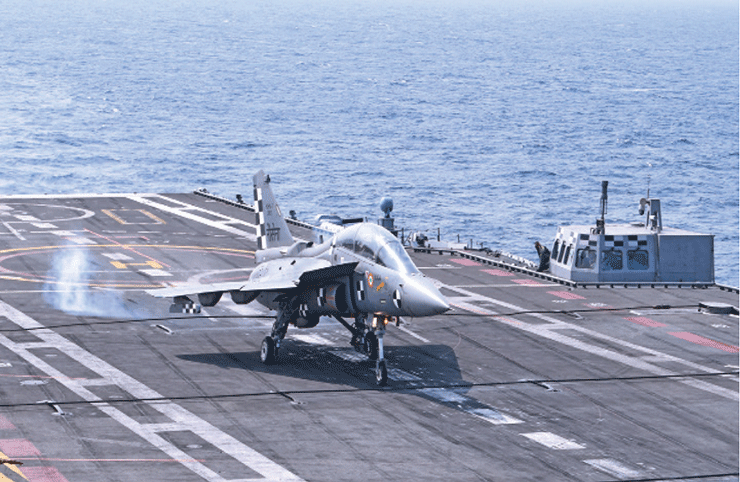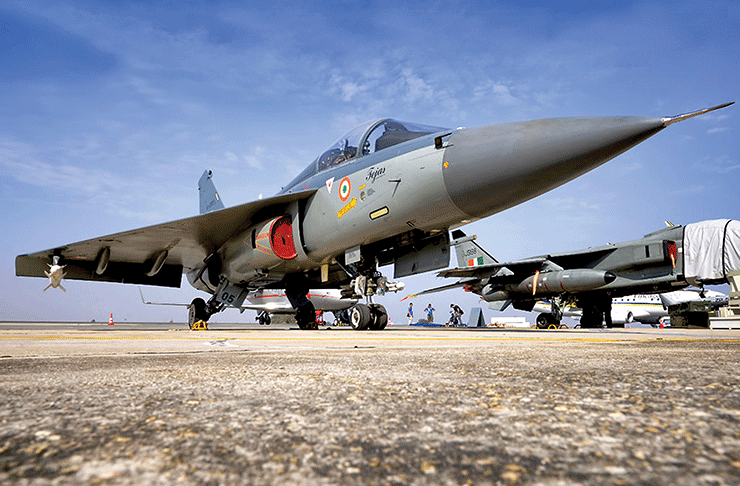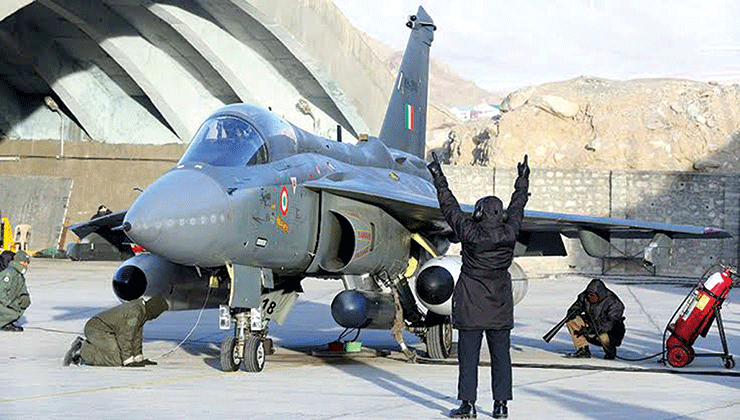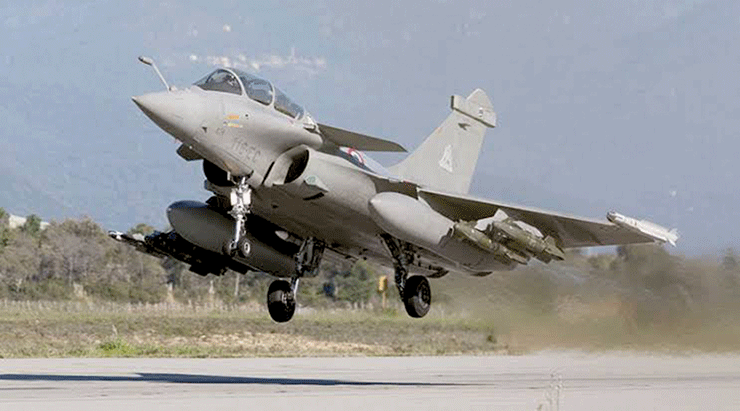
The New Year 2020 has given hopes and cause of celebration for Indian military aviation enthusiasts. The naval prototype of Tejas, India’s indigenous fourth generation fighter aircraft under development for more than three decades, made its historic first arrester cable landing on January 11 on Indian Navy’s aircraft carrier INS Vikramaditya. A day later it made its first ski-jump carrier take-off from the aircraft carrier. This is certainly a significant achievement in indigenous capability. However, it must also be remembered that the Navy has stated that the single-engine Tejas does not meet its requirements of an operationally viable fighter.
In the same vein, it is pertinent to note that the Indian Air Force’s squadron strength continues to deplete to unacceptably low levels. In December 2019, the IAF phased out the last of its MiG-27 squadrons. Despite the induction of Rafale and Tejas, the IAF will continue to face challenges of reducing numbers and a large chunk of old platforms in its inventory.
Fighter aircraft manufacturing in India until now solely the prerogative of the DPSU, Hindustan Aeronautics Limited (HAL), is likely to change in the near future. This is a welcome portend, but it still continues to be a mirage in view of our archaic procedures and policy paralysis. The IAF has put out an RFI indicating the requirement of 114 fighter aircraft with manufacture in India through JV under the Strategic Partnership (SP) model while the Navy has put out a requirement for 57 twin-engine fighters for its carrier operations.
Given the fact that the IAF’s requirements will balloon to over 400 fighters, and that the Navy may aspire to strength of 150 fighters for three carrier task force plan, India will need to look at fighter aircraft manufacturing in terms of higher capacities and better supply chain control. Aspects of technology transfer and indigenous development makes the issue far more complex and needs decisions to be taken with significant strategic foresight.
Tejas – Need for holistic strategy
IAF’s first Tejas squadron, No 45 Squadron at Sulur, is now fully equipped with 16 Initial Operational Clearance (IOC) standard aircraft. HAL has announced that the first four Final Operational Clearance (FOC) aircraft will begin equipping the second squadron by March 2020. HAL expects to complete the delivery of all 40 Tejas Mk 1 aircraft by 2022-23. IAF’s contract for next batch of 83 Tejas Mk 1A is likely to be inked soon, but the series production of these will need to await completion of development testing of Mk 1A, which is unlikely to be completed by 2022. In order to avoid the disaster of a production holiday, HAL has taken the right decision to take on the production of 18 Tejas trainers during this period.
The use of Mk 1 and Mk 1A LCA fighters should generate significant user data for the design agency to make relevant improvements. This is vitally important to iron out scores of maintenance and reliability problems that are showing up in day-to-day operations. Next stage of Tejas should be the Mk 2, which should incorporate all corrections that emanate from the user data. Effectively, Tejas Mk 2, in terms of design maturity and reliability, should become the backbone of India’s fighter aircraft production over the next two decades. So what shape should the Mk 2 take? A pointer to this lies in the requirements indicated by both the IAF and the Indian Navy.

Navy has clearly indicated that it needs a twin-engine platform. Unofficial indicators from the IAF also point to a similar view. What is heartening is the fact that both HAL and ADA have indicated that they are keener to look at the viability of this option. The author had suggested such a solution to ADA and DRDO as early as 2008. The logic was quite clear. The basic LCA (Tejas Mk 1) was developed based on requirements that were relevant in the 1980s. Since major technology developments were also combined in the LCA programme, the Tejas turned out more as a technology development project and hence, it took more than three decades.
In today’s environment, the Mk 1, although a high-tech platform with significant capabilities is hampered by its small size, too low a radius of action and low mission profile duration. Besides, the Tejas is heavily import dependent that creates serious supply chain vulnerabilities and potential adverse impact on export prospects. These will need to be addressed in the Mk 2. By using all experience and success achieved in the Mk 1, and applying user data feedback, HAL and ADA could quickly develop a twin-engine model that will be larger, operationally more robust and viable, easily maintainable, and be more refined in the class of MMRCA. In effect a twin-engine LCA Mk 2 could easily rival the Rafale within 8-10 years, if all efforts are focused towards it. This could easily lead to a production run of more than 400 Mk 2s for both the IAF and the Indian Navy. Besides, if most technologies used are indigenous, it could have huge export prospects.
Viability of proposals mentioned above will need few other major decisions to be implemented as preconditions. To start with HAL – Bangalore Division (responsible for LCA design, development and manufacture) should be made an independent entity, and with possible merger of ADA with HAL’s ARDC. It should be restructured to bring in corporate efficiency and accountability. Government should divest its holding to 10 per cent but hold a golden veto, and invite risk-sharing private investment.

In the time period when Tejas Mk 1 and Mk 1 A aircraft are in production (easily up to 2029-30), significant import substitution should take place by focusing on development of radar, EW and allied equipment, sensors, weapons, communication systems, avionics, aggregates and major components like actuators, materials such as carbon prepegs, and complete maintenance and training subsystems. Much of all this development and manufacture should take place in the private sector. By the time we complete Mk 2 development, the LCA eco-system should be 80 per cent indigenous and in full control of the supply chain. This is vital for India to become a military aerospace exporter.
Technology Acquisition and Risk-sharing Partnership
Parallely, 114 fighter aircraft procurement of the IAF and 57 aircraft requirement of the Indian Navy should be decided quickly so that the selected OEM, in partnership with Indian strategic partner, creates a robust fighter aircraft manufacturing eco-system. This would be a challenge because other HAL, there is no other Indian industry with any meaningful aircraft manufacturing experience.
However, some pre-emptive positioning by foreign OEM and Indian industries have taken place in anticipation. Boeing, HAL, and Mahindra have formed a consortium for Boeing’s F-18 Super Hornet platform, while Tatas have combined with Lockheed Martin for the latter’s F-16 Block 70 (renamed as F-21, clearly a ploy to come around Indian politicians’ reluctance on F-16 as it is operated by Pakistan). The third likely contender, Swedish Gripen, is in possible arrangement with Adani Defence. Three other contenders; Rafale, Eurofighter, and Russian Su-35 have not made any movement. Selection through a competitive process may not be a good option, given the past experience of the unsuccessful, long-drawn out MMRCA process.
A quick and bold decision by the government on the basis of strategic interests, technology access, risk-sharing investment, ensuring the development of an export-driven eco-system, and joint ventures driven by co-design and co-development in future projects would be a better option. The selected aircraft OEM should provide technology and risk-sharing investment and accountability in future projects (AMCA).

Long-term Coherent Strategy Driven by National Interests
We need to establish a clear long-term aerospace strategy where the dots of national interests are connected so that all our acquisition and development decision making demonstrate strategic continuity. Until now we have suffered greatly due to the isolated nature of our acquisitions and development projects. An integrated fighter aircraft manufacturing strategy is the need of the hour.
– Air Marshal M Matheswaran AVSM VM PhD (Veteran) is a former Deputy Chief of Integrated Defence Staff. He is now the Chairman and President of ‘The Peninsula Foundation’, a Chennai-based policy research think tank.









